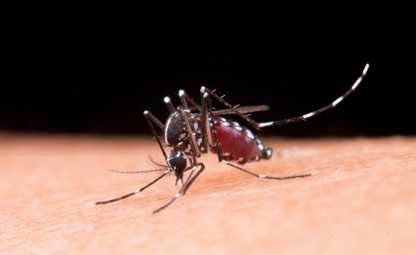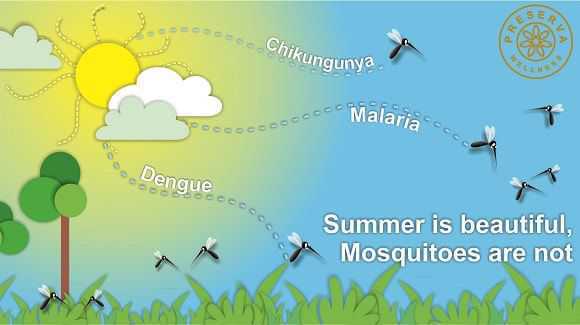Mosquitoes, are tiny insects imposing a big challenge to healthcare. They not only give us stingy bites and create an annoying buzzing sound, but also give health hazards that take millions of lives each year. Mosquitoes can breed anywhere and at any place when the climate is welcoming, especially in monsoon and breed in standing water or open drains. There are many life-threatening diseases that can spread from a single mosquito bite like Zika , Filariasis, Japanese Encephalitis and Yellow fever along with a few frequently occurring ones like Malaria, Chikungunya and Dengue. These may seem common are accountable for thousands of deaths globally.
How does Malaria spread?
Malaria is caused by the female Anopheles mosquito, which carries a Plasmodium parasite. It can also transmit through shared syringes, needles, organ transplant, and blood transfusion or from mother to foetus but can’t spread through direct contact from person to person. Anopheles mosquito mostly bites at night, usually around sunset or sunrise. The parasite enters the blood and invades the red blood cells, starts multiplying and causing frequent cycles of fever, sweating, flu like condition and chills with prominent shivering.
Plasmodium vivax, P. falciparum, P. malariae P. ovale, and P. knowlesi are the common species of plasmodium that are responsible for malaria around the world, but P.falciparum is most dangerous which is responsible for more severe conditions even may cause death if not treated promptly.
Malaria Season and Deaths in India
Malaria spreads throughout the year in India, but when the weather is wet and warm it reaches peak level starting from July till October. It is estimated that approximately more than 1 million people get infected every year in India alone, followed by few deaths (approx. more than 200 per year) and severe complications. Most effected states are Madhya Pradesh, Gujarat, Maharashtra, West Bengal, Orissa and Jharkhand. India is planning to eradicate Malaria till 2030 through various government initiated strategic plans.

How does Chikungunya spread?
Chikungunya is becoming a very common disease in India and is caused by a virus (CHIKV) which spreads and enters humans through the mosquitoes Aedes Albopictus and Aedes Aegypti that bite at night and during the day. But Chikungunya does not transmit through blood and from mother to new born. It starts with fever and joint pain which may last for months (most common symptom) accompanied by muscle pain, headache, rash and joint swelling. The probability of death is very low or rare, only very young or very old with other health complications may be at the risk.
Chikungunya Season and Deaths in India
In India, mosquitoes start rapidly breeding, once monsoon begins (July to September) which makes it necessary to initiate a mosquito control programme before monsoon. Last year, India had reported approximately 15000 cases, according to the NVB disease control programme. These cases were mostly reported in Maharashtra, Karnataka and Delhi. Every year there is a significant rise in Chikungunya which is becoming a looming threat.
How does Dengue spread?
The female Aedes Aegypti mosquito carries the dengue virus, bites a healthy person and causes the deadly disease. The Aedes mosquito lays its eggs in a water filled container or in standing water. Dengue doesn’t spread from one person to another but a person with dengue fever may infect another mosquito, which further spreads the disease. The dengue mosquito usually bites in the daytime, early morning and before sunset. It causes high fever, low platelet count, body ache etc. that may worsen and lead to death if not treated timely. Monsoon brings dirty water that worsens the situation as collected rain water becomes the perfect breeding place which is why dengue cases rise after rainfall (June through October).
Dengue Season and Deaths in India
India is going to have the highest number of dengue cases in the coming years, according to the published studies since India alone is contributing to 34% of cases worldwide. For this reason, the government needs to have an action plan to eradicate all these mosquito diseases. The people also have to be conscious to keep their surroundings clean, free of standing water etc. as the government alone cannot be successful. The cases might be higher than reported as sometimes the data does not include private cases.
Treatment or Cure of Malaria, Chikungunya and Dengue
There is no effective treatment available to completely cure Chikungunya. However, only common antipyretic and analgesic medication is used to control fever and pain related to bones and muscles. It is advisable to get plenty of rest and consume fluids to avoid any dehydration. Chikungunya is not a fatal disease but there is possibility of pain persisting for months after recovery.

Dengue vaccine is still under the process of research and development. The disease treatment depends on common medication and plenty of hydration. The same goes with Malaria, as the treatment depends entirely on the physician’s prescription and sadly there is no vaccine available so far for Malaria. If malaria is not treated in a timely manner, it may lead to serious complications such as organ failure, fluid accumulation, anaemia, breathing problems and pulmonary edema.
Protect Yourself from Mosquito Borne Diseases
Some necessary preventive measure to stay away from the menace of mosquito bites are:
- Use an approved insect repellent
- Use bed nets, mesh over windows and doors or screens to keep mosquitoes away
- Use mosquito nets for sleeping in open areas
- Clean, empty and cover all things that hold water such as flowerpots, buckets, trash containers, planters, tires, pools, coolers etc.
- Wear fully covered clothes while going out, specially to open areas
- Regularly spray the rooms with household sprays
- Always be aware of signs and symptoms for the timely treatment
- Avoid outdoor activities during the mosquito breeding season
- Contact with government agencies to fumigate your locality at the time of an outbreak
- Pay special attention to children and elderly
Why Platimore Juice is Important?
A common household remedy to get rid of dengue is by boiling giloy and papaya leaves and drinking the decoction. Platimore Juice, has been named so as it helps increase the platelet count and contains these two ingredients in a potent form in the proportions our body requires during times of poor health. It is loaded with immunity enhancing ingredients and at the same time regulates platelet count. All our strength is entirely dependent on our immune system. That is why Platimore contains tulsi or holy basil and turmeric, as the former provides plenty of Vitamin C and turmeric is the best source of anti-oxidants, is an immunity booster and has potent anti-viral property which strengthen the immune system. Aloe Vera, Giloy and Papaya cleanse and soothe the liver and enhance and restore normal platelet count which is most crucial for dengue patients.






